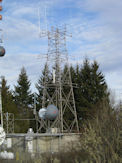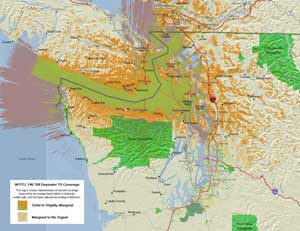W7FEL CCARC Repeater 146.760 MHz
|
Striped Peak Communications Site (click on picture to visit the W7FEL photo gallery) |
|
|
||||||||||||||||||||||||||||
|
|
|
In addition to the main 100Hz CTCSS tone, the repeater also incorporates two ‘remote receivers’ to improve repeater reception in fringe areas, covering many areas that were previously ‘dead spots’. Please visit the Technical Section to learn more about remote receivers and how they are used in this application. |
|
|
||||||||||||||||||||||||||||||
Important Information & Bulletins |
|
|
|
|
April 2015 Repeater Replacement:
|
|
|
|
|
Nets and Activities: |
|
|
|
|
Remote Receiver Project Status: The Ellis Mountain ‘west’ remote receiver is no longer available for use. Ellis Mountain is located about 15 miles north of Forks at 2600 feet. This is a ‘high site’ that was intended to extend recieve coverage for the repeater’s west coverage area. It is reported that this remote receiver was a night and day difference better than the Striped receiver out in Forks, but was subject to intermittent interference from co-located transmitters at the site. The site is no longer operational. The Carlsborg ‘east’ remote receiver is open for use. It is a ‘low-site’ that is located near the Game Farm in Sequim. With the installation of the new Yaesu repeater in April, 2015, there are some additional requirements to use this remote receiver. Please read the project documentation. The remote receivers, along with the repeater itself, all have battery backup and have the ability to operate for long periods of time on emergency power.. |
|
|
|
|
The repeater can’t stay on the air without your support ! The repeater’s equipment, operating, and maintenance costs are funded entirely by the membership of the Clallam County Amateur Radio Club, and donations to the Club. Because some of these costs are recurring on a yearly basis and ultimately absorbed by the CCARC, it is urged that all regular users of the repeater support the CCARC by maintaining membership with the Club. |
|
|
|
|
Frequency Coordination Information The W7FEL repeater’s main non-experimental components are coordinated in accordance with the Western Washington Amateur Relay Association policies and by-laws. This repeater has a co-channel agreement with the Federal Way Amateur Radio Club, which also has a repeater on the frequency of 146.760, located in the Auburn area. The FWARC repeater can be heard marginally in the east end of Clallam County, but after extensive field tests it has been determined that there is not enough evidence to claim that the FWARC system causes any 'harmful interference' to the CCARC repeater in its intended coverage area. The CCARC repeater is not heard at all in the FWARC’s coverage area. |
|
|
|
|
Repeater Contact Information: |
|
Please contact the W7FEL Repeater Trustee for additional technical information. |
|
Or you may contact the CCARC Club President for additional technical information. |


